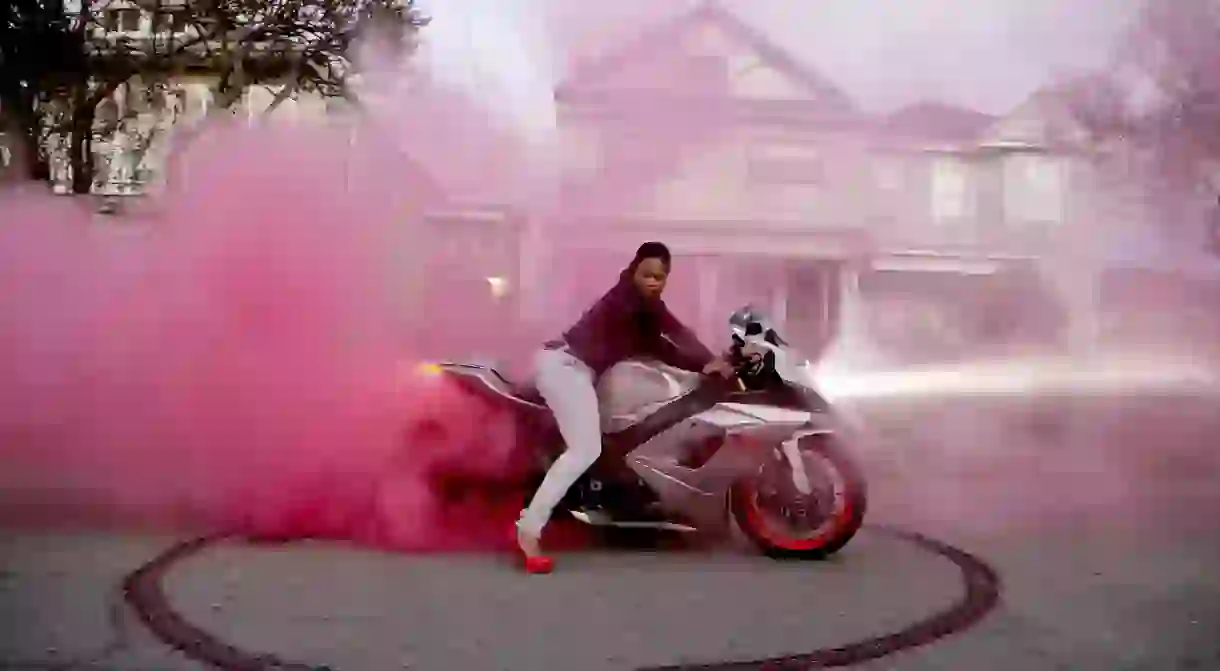Akasha Rabut’s Debut Photo Book Highlights New Orleans’ Vibrant Subcultures

The subjects of photographer Akasha Rabut’s book, Death Magick Abundance, have historically been unwelcome to participate in the hobbies they love. Rabut documents how these New Orleans residents have redefined societal norms by building their own thriving subcultures.
In her new book – Death Magick Abundance – photographer Akasha Rabut focuses her lens on subjects who have carved out their own space in niche clubs that had never thought to include them.
The photos, and their accompanying interviews, feature New Orleanians who subvert preconceived notions about who can participate in subcultures, from the women redefining who can join motorcycle clubs to the black boys and men rethinking who can ride and own horses.
Historically, subcultures haven’t been inviting to everyone. New Orleans’ all-female motorcycle club, The Caramel Curves, was established to push back at tropes that depicted women only as accessories for bikes helmed by men.

“When I was growing up, and even now, the main image in this country of a woman and a motorcycle was a white woman riding on the back, hanging onto her boyfriend,” Caramel Curves’ founder Shanika “Tru” McQuietor said in an interview for the book. “It was not a woman who was handling her own bike.”
Similarly, the Dirty South Ryderz, so-called “city cowboys,” are often assumed not to be handlers of their chosen means of conveyance.
“They say, ‘That’s your horse, for real?’” Devence Hampton, a member of the DSR club, said in an interview for the book. “When I say, ‘Yes,’ they say, ‘Oh, he lying.’”
The club has 31 members ranging in age from their 20s to their 50s, most of whom are black.
“The experience of living in New Orleans has shifted my work toward fighting racism and misogyny,” Rabut tells Culture Trip. “When I first moved to the city, I was doing fashion photography, so living here has influenced my work and informed it for the better.”

Rabut moved to the Big Easy nearly a decade ago, and while she’s since bolstered her portfolio with spreads in The New York Times, The Atlantic, The Fader and elsewhere, her interest in her adopted hometown’s people persisted. Over those 10 years, she established a rapport with the people whom she photographed, transforming them from subjects into friends.
“It was never about photography,” Rabut says. “It was about sharing experiences with other people and building trust. Through nurturing long-lasting relationships, fortunately people have opened up to me. Because of this, I prefer to photograph projects long-term, because time allows me to emotionally process making these intimate images.”

These groups already existed, but fostering connections with their members allows Rabut to spread their message of community building to others. Part of community building is establishing ethos, and both DSR and CC take pride in their presentation, much like the Mardi Gras Indians whom Rabut also photographed.
“We want to be cute on our bikes,” McQuietor said. “We wear heels and makeup, lashes and nails, and changed the perception of what a biker girl is supposed to look like.”
Older members of DSR mentored the younger ones by offering tough lessons. For example, tradition stipulates you must be presentable: your horse must be clean, and your tack, the accessories used on domesticated horses, should be one color.

“One day, I pulled up, my horse was dirty,” DSR member Chris Carr said in an interview for the book. “My tack was pink, purple, yellow and blue. And they looked at me and said, ‘You not riding with us.’ I had to take my horse and go back to the stall. I couldn’t ride that day.”
Dressing up is an opportunity for New Orleans residents to show off their individuality. The characters who populate the pictures in the book never balk at the chance to be audacious.
In the book’s intro, photographer Sam Feather puts it this way: “In a city where so much is oriented toward outsiders, the [Mardi Gras] parade is not for sale, not advertised, not sponsored by corporations, not accompanied by souvenirs.”

The parade happens for two weeks, but the lifestyle bleeds out of the lines. As Feather says, “We [the people of New Orleans] are the parade.”
This brash culture is passed down from one generation of New Orleanians to the next.
“I was at a second line [parade], and one little boy must have followed me for fifteen blocks,” Hampton said. “I’m looking at him, and I see me! I’m like, ‘Alright, let me let him ride,’ because I know the feeling.”













